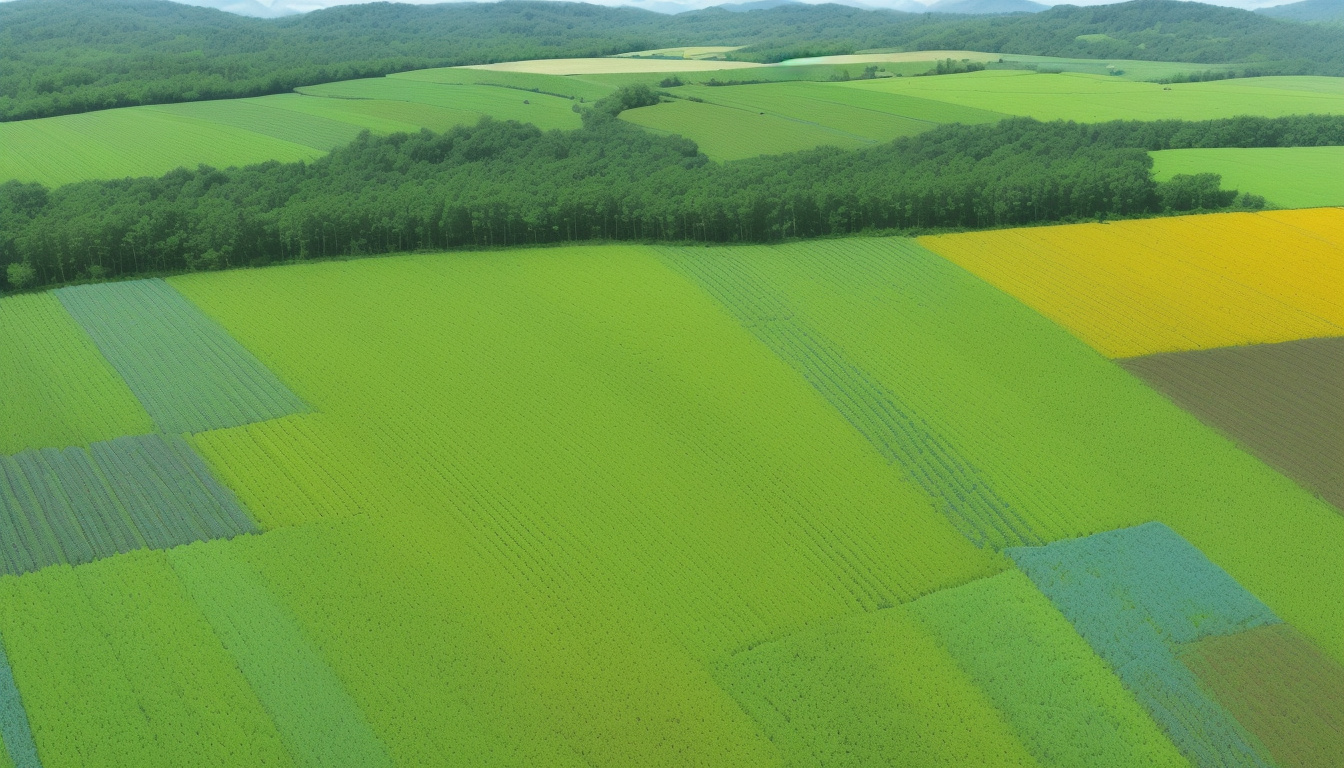The Power of Climate-Smart Agriculture for Sustainable Farming

Hey there, fellow farming enthusiasts and health-conscious consumers! Have you ever wondered how we can meet the growing global demand for food while also protecting our planet? Well, let’s talk about an exciting solution that’s gaining momentum in the farming community: climate-smart agriculture. This innovative approach not only helps farmers adapt to the ever-changing climate but also ensures the sustainability of our food systems. In this article, we’ll dive deep into the fascinating world of climate-smart agriculture, exploring its principles, benefits, challenges, and the bright future it promises for both farmers and communities around the globe.
Interested in our Digital Magazine APP?

Here's a thought
- Climate-smart agriculture focuses on sustainable practices that increase productivity while reducing emissions.
- It is crucial in mitigating the impacts of climate change on global food security.
- Innovative technologies, like precision farming and agroforestry, enhance the effectiveness of climate-smart agriculture.
- Farmers and communities gain economic, social, and environmental benefits through the adoption of these practices.
- Overcoming challenges such as funding and education is essential to fully realize the potential of climate-smart agriculture.
Understanding Climate-Smart Agriculture: Definitions and Principles
When we talk about climate-smart agriculture, we're diving into an innovative approach that not only aims to increase agricultural productivity but also addresses the pressing challenges of climate change and food security. So, what exactly is climate-smart agriculture? At its core, it encompasses farming practices that enhance resilience to climate change while reducing agricultural greenhouse gas emissions.
The principles are straightforward yet impactful: firstly, it promotes sustainable land management and soil health, ensuring that our farming practices contribute positively to the environment. Secondly, it encourages the efficient use of water and energy, helping farmers like you save on costs and resources. Lastly, climate-smart agriculture fosters diverse cropping systems that can withstand extreme weather events, thereby safeguarding food production.
For health enthusiasts and consumers alike, embracing these methods not only supports local farmers but also ensures that the food on your plate is produced sustainably, contributing to a healthier planet.
The Importance of Climate-Smart Agriculture in the Face of Climate Change
As we navigate the challenges posed by climate change, it's essential to consider the significance of climate-smart agriculture. This innovative approach not only addresses the pressing concerns of food security but also champions sustainability. By utilizing methods that improve resilience to extreme weather conditions, farmers can ensure their crops thrive while reducing greenhouse gas emissions.
Health enthusiasts can celebrate this proactive strategy as it promotes healthier soil and ecosystem vitality, ultimately leading to better quality produce for consumers. Engaging in climate-smart agriculture means embracing practices like crop rotation, organic farming, and soil conservation, which are vital for both our planet's health and our dietary well-being.
Whether you’re a farmer looking to adapt to changing conditions or a health-conscious consumer eager for sustainably sourced food, understanding climate-smart agriculture is crucial for a prosperous future.
'The greatest threat to our planet is the belief that someone else will save it.' – Robert Swan
Innovative Practices and Technologies in Climate-Smart Agriculture
Climate-smart agriculture is revolutionizing the way we approach farming, providing innovative practices and technologies that not only enhance productivity but also promote sustainability.
Farmers are increasingly adopting techniques such as precision farming, which utilizes satellite technology and drones to optimize the use of resources, thereby reducing waste and environmental impact. Cover cropping and agroforestry are also gaining traction, as these methods improve soil health and increase carbon sequestration.
For health enthusiasts, this means more nutritious, locally-grown food options that are cultivated with care for our planet in mind. Moreover, innovations in irrigation systems, such as drip and smart irrigation, allow for maximum efficiency, ensuring crops get the right amount of water while conserving this precious resource.
Embracing climate-smart agriculture not only improves the resilience of our food systems but also supports farmers in adapting to the challenges posed by climate change, making it a win-win for consumers, health advocates, and agricultural communities alike.
Interested in our Digital Magazine APP?

Benefits of Climate-Smart Agriculture for Farmers and Communities
Hey there! If you’re curious about how farmers and communities can thrive while tackling climate change, let’s dive into the benefits of climate-smart agriculture. This innovative approach isn't just about growing more food; it’s about growing better food. By adopting practices that enhance productivity and resilience to climate variations, farmers can increase their yields while reducing greenhouse gas emissions.
This means healthier crops that not only support the farmer's income but also uphold environmental sustainability. For communities, the shift to climate-smart agriculture can lead to improved food security, as these methods help ensure a steady supply despite unpredictable weather patterns. Imagine a world where farmers use techniques that enhance soil health and conserve water resources, while also empowering local economies and creating a robust, sustainable food system. Plus, products from climate-smart practices can appeal to health-conscious consumers looking for eco-friendly options, which further stimulates local markets.
So, whether you’re a farmer or a health enthusiast, understanding and supporting this approach can pave the way for a sustainable future—one where food production and environmental stewardship go hand in hand!
Challenges and Barriers to Implementing Climate-Smart Agriculture
When we talk about climate-smart agriculture, it’s crucial to acknowledge the various challenges and barriers that farmers and health enthusiasts face when trying to implement these practices. One significant barrier is the initial financial investment necessary for transitioning to new farming methods and technologies. Many farmers, particularly smaller operations, may struggle to secure funding or access resources that support climate-smart practices, such as crop diversification or improved irrigation systems. Additionally, a lack of knowledge or training on these innovative techniques can hinder adoption. Farmers may be hesitant to change long-established methods without clear information on the potential benefits. Furthermore, climate-smart agriculture often requires collaboration among various stakeholders, including local governments and agricultural organizations, which can be difficult to coordinate, especially in regions where communication channels are weak. Lastly, policy frameworks may not yet be fully aligned with the goals of climate-smart practices, creating further obstacles for those eager to adapt. Tackling these challenges is essential for achieving sustainable agriculture that not only protects our environment but also promotes health and well-being across the community.
Here's something people ask about
What is climate-smart agriculture?
Climate-smart agriculture refers to integrated approaches that help to manage agricultural systems in ways that increase productivity while enhancing resilience to climate change, reducing greenhouse gas emissions, and improving food security. It combines sustainable farming practices with modern technologies.
Why is climate-smart agriculture important?
Climate-smart agriculture is crucial because it helps farmers adapt to climate change, protects ecosystems, and promotes food security. As climate change poses significant risks to food production, these sustainable practices are essential for ensuring future agricultural resilience.
What are some innovative practices in climate-smart agriculture?
Innovative practices include agroforestry, crop rotation, improved irrigation techniques, cover cropping, precision farming, and the use of drought-resistant crop varieties. These practices can enhance soil health, increase biodiversity, and optimize resource use.
What benefits do farmers and communities gain from climate-smart agriculture?
Farmers can experience increased productivity, reduced costs, improved soil health, and enhanced resilience to climate-change-related shocks. Communities benefit from strengthened food security, improved livelihoods, and a healthier environment.
What are the challenges associated with implementing climate-smart agriculture?
Challenges include limited access to technology, lack of financial resources, insufficient knowledge or training among farmers, policy barriers, and resistance to change within communities. Overcoming these requires targeted efforts and support from governments and NGOs.
We're striving to bring a range of different topics that relate to the Farming Food & Health sector. If you've got a question, please feel free to contact us.
We publish a quarterly magazine available in IOS, Android and Web reader. Stories and articles curated from amazing people all around the world.



